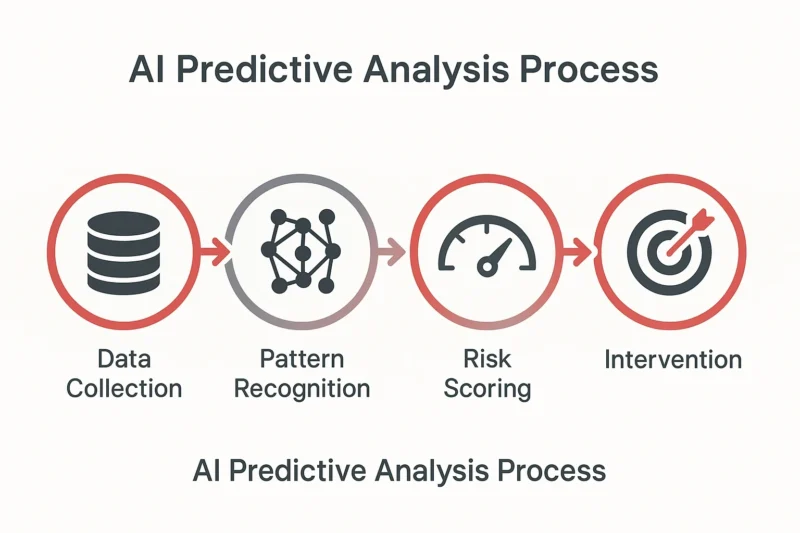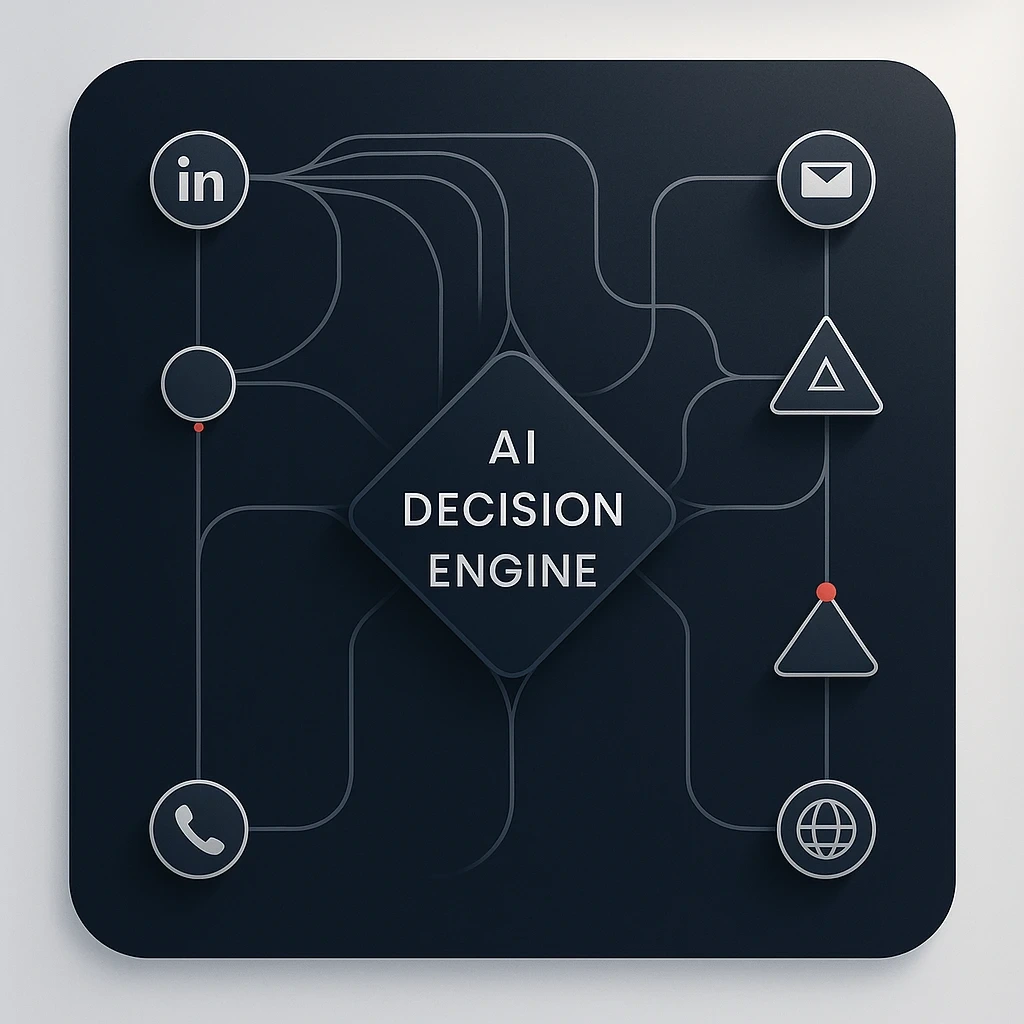How to Optimize AI Campaign Sequences for LinkedIn ABM
The numbers tell a compelling story: AI-powered LinkedIn ABM campaigns achieved 37% higher engagement rates than non-AI approaches in 2024-2025 enterprise programs. For CMOs and marketing operations leaders grappling with shrinking budgets and rising acquisition costs, this isn’t just a marginal improvement—it’s the difference between meeting pipeline targets and missing them entirely.
The challenge is how to optimize these sequences to deliver transformational results rather than incremental gains. The most successful B2B teams are discovering that AI doesn’t just automate their existing processes; it fundamentally reimagines how account-based marketing sequences can nurture high-value prospects through increasingly complex buyer journeys.
This comprehensive guide reveals the proven strategies, frameworks, and optimization techniques that industry leaders are using to turn LinkedIn ABM sequences into revenue-generating machines. You’ll discover how to harness AI’s predictive power while maintaining the human insight that drives deal closings.
Key Takeaways
- AI-powered LinkedIn ABM sequences deliver 37% higher engagement rates compared to traditional approaches, with successful implementations reducing lead costs by 42% while increasing engaged accounts by 28%
- Progressive personalization dramatically improves conversion rates as you advance from company-level (+23% open rates) to role-based (+41% response rates) to individual-level optimization (+67% meeting conversion)
- Real-time optimization outperforms traditional A/B testing by continuously analyzing engagement patterns and adjusting messaging strategies
- Intent signal integration enables dynamic sequence adjustments that automatically accelerate high-intent prospects or move low-engagement contacts to longer nurture sequences based on behavioral triggers
- Success measurement requires account-level metrics beyond basic impressions, including engagement depth, pipeline attribution, and deal velocity improvements, to properly evaluate how to optimize AI campaign sequences for LinkedIn ABM
TABLE OF CONTENTS:
The AI Advantage: Why Traditional LinkedIn ABM Falls Short
Traditional LinkedIn ABM sequences operate like clockwork: predictable and linear, which are becoming increasingly ineffective. Decision-makers are bombarded with generic outreach, and conventional targeting methods struggle to distinguish between accounts that show genuine buying intent and those that are simply browsing.
AI transforms this equation by introducing three critical capabilities that manual processes simply cannot match: predictive targeting accuracy, dynamic personalization at scale, and real-time sequence optimization based on engagement patterns.
“The most successful AI-driven LinkedIn ABM campaigns don’t just replace human decision-making. They amplify human strategic thinking by handling the data-intensive optimization work that would otherwise consume entire marketing teams.”

Building Your AI-Powered LinkedIn ABM Framework
The foundation of effective AI optimization lies not in the technology itself, but in the strategic framework that guides its application. Successful implementations follow a three-phase approach: intelligent account selection, personalized sequence orchestration, and continuous performance optimization.
Phase One: Intelligent Account Selection and Segmentation
AI-driven account selection moves beyond traditional firmographic data to incorporate behavioral signals, intent data, and predictive scoring models. The most effective teams are combining LinkedIn’s native AI features with external platforms to create multi-layered targeting approaches.
Early adopters of LinkedIn’s AI-powered ‘Accelerate’ tool with Predictive Audiences reported a 21% reduction in cost-per-lead while launching optimized ABM sequences in under five minutes. This dramatic efficiency gain stems from AI’s ability to analyze web behavior, historical ad performance, and engagement patterns to automatically generate optimized creative assets, bidding strategies, and account lists.
The key is establishing clear criteria for your Ideal Customer Profile (ICP) that AI can optimize against. This includes not only company size and industry, but also behavioral indicators such as content engagement patterns, technology adoption signals, and buying stage indicators.
Phase Two: Personalized Sequence Orchestration
This is where AI’s true power emerges. Rather than creating static, one-size-fits-all sequences, AI enables dynamic personalization that adapts based on individual prospect behavior and account characteristics.
| Personalization Level | Traditional Approach | AI-Optimized Approach | Impact on Engagement |
|---|---|---|---|
| Company-Level | Company name insertion | Industry-specific pain points, recent news integration | +23% open rates |
| Role-Based | Job title reference | Role-specific challenges, decision-making priorities | +41% response rates |
| Individual-Level | Manual research notes | Content preferences, engagement history, timing optimization | +67% meeting conversion |
The progression from company-level to individual-level personalization creates exponentially better results. AI makes this scalable by automatically researching prospects, identifying relevant talking points, and even optimizing send times based on individual engagement patterns.
Phase Three: Continuous Performance Optimization
Unlike traditional A/B testing, which requires weeks to reach statistical significance, AI-driven optimization occurs in real-time. Machine learning algorithms continuously analyze engagement patterns, adjust messaging strategies, and optimize sequence timing to maximize conversion rates.
The results speak for themselves: AI-driven LinkedIn ABM campaigns reduced client lead costs by 42% while increasing the number of engaged accounts by 28%. This dual improvement, lower costs and higher engagement, demonstrates AI’s ability to optimize for efficiency and effectiveness simultaneously.
Advanced AI Optimization Techniques for Maximum Impact
Once your foundational framework is operational, advanced optimization techniques can drive breakthrough performance improvements. These strategies distinguish between good AI implementations and transformational ones.
Predictive Sequence Timing and Channel Selection
AI algorithms can analyze historical engagement data to predict optimal timing for each touchpoint in your sequence. This goes beyond basic day-of-week optimization to include individual prospect behavior patterns, industry-specific timing preferences, and real-time engagement signals.
Advanced implementations use multi-channel orchestration, automatically determining whether a prospect is more likely to engage with sponsored content, InMail, or connection requests based on their historical behavior patterns and current engagement stage.
Dynamic Creative Optimization
Rather than creating static ad variations, AI can generate and test creative elements in real-time. This includes headline variations, image selection, call-to-action optimization, and even video thumbnail testing.
Consider the transformation experienced by an enterprise B2B software company that implemented the AI-driven tool Karrot.ai, which personalizes its LinkedIn ABM sequences. The company achieved a 64% improvement in MQL-to-opportunity conversions.
Intent Signal Integration and Behavioral Triggers
The most sophisticated AI implementations integrate multiple intent signals to trigger sequence adjustments in real-time. This includes website behavior, content downloads, social media engagement, and third-party intent data.
When a prospect shows high-intent behavior, AI can automatically accelerate the sequence, introduce more aggressive calls-to-action, or trigger direct sales outreach. Conversely, low-engagement prospects might be moved to nurture sequences longer or excluded from high-touch campaigns.

Measuring Success: Essential Metrics for AI-Driven ABM
Traditional LinkedIn metrics like impressions and clicks provide limited insight into AI-optimized ABM performance. Success measurement requires a more sophisticated approach that tracks account-level engagement, pipeline influence, and multi-touch attribution.
Engagement Depth and Quality Indicators
AI-optimized sequences should be measured by engagement quality, not just quantity. AI-optimized LinkedIn ABM sequences yielded an average reply rate of 19.98%, with 48.14% of replies converting into meetings. These benchmarks provide concrete targets for campaign optimization.
Key metrics to track include response depth (single-word responses vs. detailed replies), meeting acceptance rates, and progression through your sales funnel stages. AI can help identify which personalization elements drive the highest-quality engagement.
Pipeline Attribution and Revenue Impact
The ultimate measure of AI optimization success is sales pipeline impact. This requires sophisticated attribution modeling that tracks account interactions across multiple touchpoints and channels.
Effective measurement systems track account journey progression, time-to-opportunity metrics, and deal velocity improvements. The most successful implementations can directly correlate AI optimization efforts with shortened sales cycles and increased deal sizes.
Common Pitfalls and How to Avoid Them
Even well-intentioned AI implementations can fail to deliver expected results. Understanding these common pitfalls helps ensure your optimization efforts drive real business impact.
The Over-Automation Trap
The biggest mistake teams make is assuming AI can replace human strategic thinking. Successful implementations utilize AI to amplify human insight, rather than replace it. Sales teams still need to provide context about account relationships, competitive dynamics, and deal-specific nuances. The solution involves establishing clear boundaries, where AI handles data processing and optimization, while humans guide strategy, relationship management, and complex decision-making.
Data Quality and Integration Challenges
AI optimization is only as good as the data feeding it. Poor CRM hygiene, disconnected systems, and incomplete prospect information will limit the effectiveness of AI, regardless of the sophistication of your tools.
Address this by implementing robust data governance practices, establishing clear data quality standards, and ensuring seamless integration between your LinkedIn campaigns, CRM system, and marketing automation platform.
Your Next Steps to ABM Excellence
The evidence is clear: AI-optimized LinkedIn ABM sequences not only outperform traditional approaches but also yield significant benefits. They’re redefining what’s possible in B2B marketing. The question isn’t whether to implement AI optimization, but how quickly you can transform your current approach to capitalize on these performance improvements.
Start with your highest-value account segments where improved performance will have the most significant business impact. Implement progressive personalization gradually, beginning with company-level customization before advancing to individual-level optimization. Most importantly, establish clear measurement frameworks that can demonstrate ROI to stakeholders and guide continuous improvement efforts.
The teams winning in 2025 aren’t just using AI tools. They’re thinking strategically about how AI can amplify their account-based marketing effectiveness while maintaining the human relationships that close deals. For more detailed guidance on implementing successful LinkedIn ABM campaigns, explore our comprehensive implementation guide.
Ready to discover how AI optimization can transform your LinkedIn ABM performance? Get Your Free ABM Audit to identify specific opportunities for improvement in your current campaigns and develop a customized optimization strategy that drives measurable results.
Ready to turn your LinkedIn ABM into a revenue-generating machine instead of just another marketing expense?
Related Video
For more insights and lessons about marketing, check out our Marketing School podcast on YouTube.
Frequently Asked Questions
-
What makes AI-powered LinkedIn ABM sequences more effective than traditional approaches?
AI introduces three critical capabilities that manual processes cannot match: predictive targeting accuracy, dynamic personalization at scale, and real-time sequence optimization based on engagement patterns. This results in 37% higher engagement rates and a 42% reduction in lead costs while increasing engaged accounts by 28%.
-
How should I structure personalization levels in my AI-optimized sequences?
Start with company-level personalization (industry-specific pain points) for +23% open rates, then progress to role-based targeting (decision-making priorities) for +41% response rates. Individual-level optimization using content preferences and engagement history delivers the highest impact with +67% meeting conversion rates.
-
What metrics should I track to measure AI-driven ABM success?
Focus on engagement quality over quantity, tracking response depth, meeting acceptance rates, and pipeline progression rather than just impressions and clicks.
-
How does AI handle sequence timing and channel optimization?
AI analyzes historical engagement data to predict optimal timing for each touchpoint and automatically determines the best channel (sponsored content, InMail, or connection requests) based on individual prospect behavior patterns. This includes real-time adjustments based on engagement signals and intent data.
-
What integration capabilities do I need for effective AI ABM implementation?
You need seamless integration between LinkedIn campaigns, your CRM system, and marketing automation platform to ensure data quality. AI optimization requires clean data feeds from multiple sources including website behavior, content downloads, social media engagement, and third-party intent data.
-
What's the biggest mistake companies make when implementing AI for LinkedIn ABM?
The over-automation trap where teams assume AI can replace human strategic thinking entirely. Successful implementations use AI to amplify human insight by handling data processing and optimization while humans guide strategy, relationship management, and complex decision-making.
-
How quickly can I expect to see results from AI-optimized LinkedIn ABM sequences?
Unlike traditional A/B testing that requires weeks to reach statistical significance, AI-driven optimization happens in real-time with continuous performance improvements. Start with your highest-value account segments and implement progressive personalization gradually, beginning with company-level customization before advancing to individual-level optimization.




